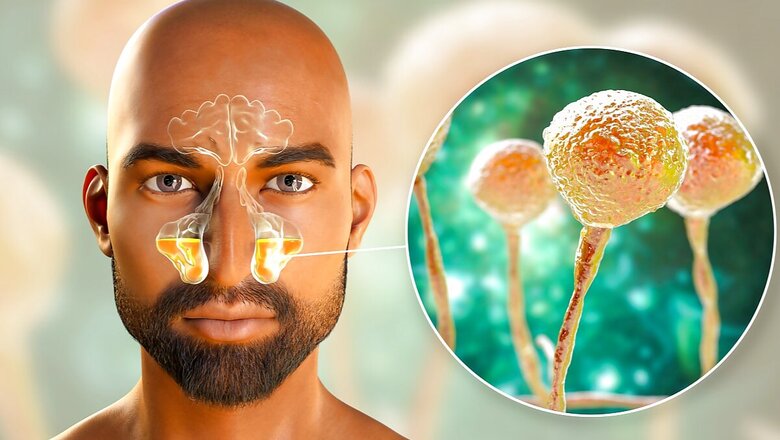
views
Recently, black fungus was declared as an epidemic in India, but just a few weeks later, four cases of white fungus also came to light in Patna. On Monday, a case of yellow fungus emerged in Uttar Pradesh’s Ghaziabad. Meanwhile, the first case possibly of green fungus infection linked to Covid-19 has been reported in Madhya Pradesh in a person who had recovered from the viral infection. With different types of deadly fungus emerging one after the other, people are scared and confused, since the difference between the three types of fungus is not clear. Also, it is unclear which kind of fungus is more dangerous for humans.
While black, white and yellow fungus are caused by mucormycetes, the green fungus is caused by aspergillus. Both the types of fungus are present in our environment. Read on to know more about the three fungus:
Black fungus
Mucormycosis or black fungus can impact a patient’s face, nose, eye orbit and even brain, which can lead to vision loss. This type of fungus can also spread to the lungs. According to Randeep Guleria, the director of All India Institute of Medical Sciences (AIIMS), black fungus mostly occurs due to the misuse of steroids.
Who is at risk: It has been found that people having diabetes, Covid-19 patients and those who have been consuming steroids for many days are at a higher risk of getting infected with black fungus. It is said that even staying in ICU for a long period can increase the risk of black fungus.
Symptoms: In recent weeks, it has been found that those who are recovering from Covid are mostly contracting black fungus. Some common symptoms of its early detection are discolouration over the nose, blurred vision, pain on one side of the face, toothache, pain in the chest and breathlessness. In some cases, it has been found that infected patients have also coughed out blood. It can turn fatal if not treated on time.
White fungus
According to recent cases, white fungus is found to be more dangerous than black fungus. Doctors have also warned that if the fungus is not attended to on time, it can lead to death. It badly affects the lungs and can cause damage to the brain, respiratory system and digestive tract.
Who is at risk: White fungus mostly attacks people who have low immunity. Also, unsanitary places with molds make a perfect environment for anyone to catch this infection. Though this fungal infection is not contagious, people around the infected person can catch it by inhaling it if they have low immunity. Diabetic and cancer patients and those consuming steroids for long are at a higher risk.
Symptoms: Some early symptoms of white fungus are quite similar to coronavirus symptoms. A patient can have pain in the chest, cough, breathlessness, headache, body pain, infection in some body parts or swelling.
Yellow fungus
According to experts, yellow fungus is the most lethal of the three types of fungus discovered till now. It usually affects reptiles and now its first case in human beings has been reported in Ghaziabad. While not much is known about the infection, it is important to know that this kind of infection starts due to unsanitary conditions.
Who is at risk: People who have poor hygienic surroundings are said to be at higher risk of getting infected with yellow fungus. Besides, it can also be caused by contaminated food, overuse of steroids, antibacterial medications and poor oxygen use. It has been advised to keep the surroundings clean and humid free, and remove old foods and faecal matter as soon as possible so that bacteria and fungus do not grow.
Symptoms: Yellow fungus starts off internally. Some early symptoms of it include pus leakage, slow healing of wounds, lethargy, lack of appetite, loss of weight and sunken eyes. In severe cases, it can also show devastating symptoms like organ failure. Experts have advised to consult a doctor as soon as a person notices any infection in the body or any other early symptoms.
GREEN FUNGUS
It is an infection caused by Aspergillus, a common type of fungus that is found inside homes and outside in the open. The medical name for this disease is Aspergillosis. According to the US disease watchdog Centres for Disease Control and Prevention (CDC), “most people breathe in Aspergillus spores every day without getting sick”. Spores are minute single-celled reproductive cells that are produced by everything from bacteria, fungi, algae, and plants.
Although some allergic green fungus attacks may not cause infection, the CDC notes that it can also cause chronic pulmonary aspergillosis that results in cavities in the lungs and can take 3 months or more to cure. Further, invasive aspergillosis, in which green fungus causes a serious infection, can affect “people who have weakened immune systems, such as people who have had an organ transplant or a stem cell transplant”. Invasive aspergillosis typically affects the lungs, but can also spread to other parts of the body.
Then there is cutaneous, or skin, aspergillosis. Although it commonly occurs in people with weakened immune systems when green fungus enters the body through a rupture in the skin, there are instances of it occurring after invasive aspergillosis spreads to the skin from somewhere else in the body, such as the lungs.
Who is at risk: As noted above, green fungus is commonly present in the environment and can be encountered in decaying leaves, compost, plants, trees and grain crops. However, as the US-based Mayo Clinic notes, “everyday exposure to aspergillus is rarely a problem for people with healthy immune systems. When mold spores are inhaled, immune system cells surround and destroy them”. But the various types of infection that green fungus can cause are commonly seen affecting people who have cystic fibrosis or asthma or lung diseases like tuberculosis.
Chronic pulmonary aspergillosis, as the name suggests, can affect people who have other lung diseases, like tuberculosis, chronic obstructive pulmonary disease (COPD), etc. People with weakened immune systems — for instance those who’ve had an organ transplant or are undergoing chemotherapy for cancer, or taking high doses of corticosteroids (like some Covid-19 patients do) — are at risk of developing invasive aspergillosis. However, aspergillosis does not spread between people or between people and animals from the lungs.
Symptoms: The different types of infections that green fungus may trigger can have different symptoms. For instance, when the green fungus triggers an allergic reaction in the lungs (allergic bronchopulmonary aspergillosis, or ABPA), it produces symptoms similar to asthma like wheezing, shortness of breath, coughing and fever in rare cases. When the allergy attacks the sinuses, it can cause stuffiness, runny nose, headache and, in a symptom common with Covid-19, reduced ability to smell.
Chronic pulmonary aspergillosis that affects the lungs can lead to weight loss, coughing, coughing up of blood, fatigue and shortness of breath.
As for invasive aspergillosis, which the CDC said “usually occurs in people who are already sick from other medical conditions”, symptoms can include fever, chest pain, coughing, coughing up of blood, shortness of breath, etc. Further, “other symptoms can develop if the infection spreads from the lungs to other parts of the body”.
Read all the Latest News, Breaking News and Coronavirus News here.




















Comments
0 comment